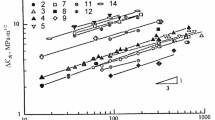Abstract
Corrosion-assisted propagation of an existing crack is profoundly influenced by the stress intensity at the crack tip. This article presents the first results of thermomechanical conditioning (TMC) for local manipulation of material at and ahead of the crack tip, in an attempt to retard/stop crack propagation. Prenotched round tensile specimens of mild steel were subjected to rotating bending to generate a fatigue precrack, and then to apply localized thermomechanical conditioning. The threshold stress intensity factor (K ISCC ) for stress corrosion cracking (SCC) of precracked specimens with and without TMC was determined in a caustic environment. Results suggest that TMC can increase K ISCC . Finite element analysis of the specimens suggests development of compressive stresses at and around the crack tip, which is expected to improve the resistance to stress corrosion crack propagation (since stress corrosion cracks can propagate only under tensile loading).











Similar content being viewed by others
References
R.K. Singh Raman: Mater. Sci. Eng. A, 2006, vol. 441, p. 342
D. Singbeil, D. Tromans: Metall. Trans. A, 1982, vol. 13A, p. 1091
R. Sriram, D. Tromans: Metall. Trans. A, 1985, vol. 16A, p. 979
Y.C. Lam, J.R. Griffiths: Theor. Appl. Fract. Mech., 1990, vol. 14, p. 37
B.R. Chen, J.R. Griffiths, Y.C. Lam: Eng. Fract. Mech., 1993, vol. 44, p. 567
R.N. Ibrahim, Y.C. Lam: Fatigue Fract. Eng. Mater. Struct., 1994, vol. 17 (3), p. 277
R.N. Ibrahim: Eng. Fract. Mech., 1998, vol. 59 (2), p. 215
R.N. Ibrahim, D. Ischenko: J. Eng. Mater. Technol., 1998, vol. 120, p. 297
J. Sedriks: Publications of National Association of Corrosion Engineers, NACE, Houston, TX, 1990
Proc. Environment-Sensitive Fracture, Symp. ASTM Committee G-1, ASTM Special Technical Publication 821, S.W. Dean, E.N. Pugh, and G.M. Ugiansky, eds., ASTM, Philadelphia, PA, 1982
R.K. Singh Raman, R. Rihan, R.N. Ibrahim: Metall. Mater. Trans. A, 2006, vol. 37A, p. 2963
R.K. Singh Raman: Metall. Mater. Trans. A, 2005, vol. 36A, p. 1817
R. Rihan, R.K. Singh Raman, R.N. Ibrahim: Mater. Sci. Eng. A, 2006, vol. 425, p. 272
R.N. Ibrahim, H.L. Stark: Eng. Fract. Mech., 1986, vol. 25 (4), pp. 395–401
R.N. Ibrahim, H.L. Stark: Int. J. Fract., 1990, vol. 44, pp. 179–88
R.N. Ibrahim, H.L. Stark: Eng Fract. Mech., 1987, vol. 28 (4), pp. 455–60
H.L. Stark, R.N. Ibrahim: Eng. Fract. Mech., 1988, vol. 30, p. 409
Acknowledgments
This work was carried out as part of a project funded under the Discovery grant scheme of the Australian Research Council (ARC). The authors are grateful for the support of the ARC and the Monash University Department of Mechanical Engineering.
Author information
Authors and Affiliations
Corresponding author
Additional information
Manuscript submitted December 17, 2007.
Appendix
Appendix
In order to account for the eccentricity, the specific method used for the determination of the centroid of the ligament was as follows.
The fatigue crack depth (a f ) was measured at twelve 30 deg intervals, as shown in Figure 12, by using a profile projector. The area of the ligament that associates with each 30 deg wedge is
where a m is the depth of the machined notch (m).
The total area of the ligament is
Therefore, the equivalent ligament diameter is
The first moments of area of a 30 deg wedge about the X and Y axes, respectively, are
The total moments of area of the 12 wedges about the X and Y axes are
Then, dividing these moments of area (Eqs. [f] and [g]) by the ligament area (Eq. [b]) gives the coordinates of the centroid of the ligament (Figure 5).
Therefore, the eccentricity (ε) is
Rights and permissions
About this article
Cite this article
Singh Raman, R., Ibrahim, R., Wu, F. et al. Thermomechanical Manipulation of Crack-Tip Stress Field for Resistance to Stress Corrosion Crack Propagation. Metall Mater Trans A 39, 3217–3223 (2008). https://doi.org/10.1007/s11661-008-9665-4
Published:
Issue Date:
DOI: https://doi.org/10.1007/s11661-008-9665-4





